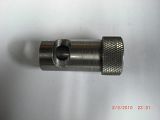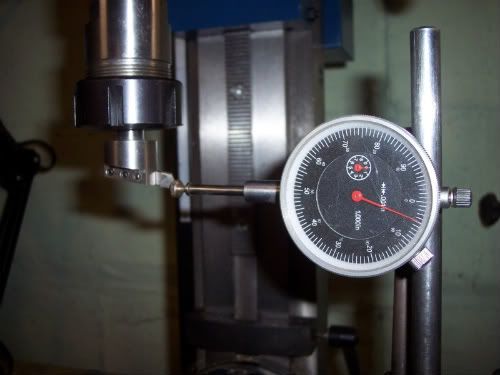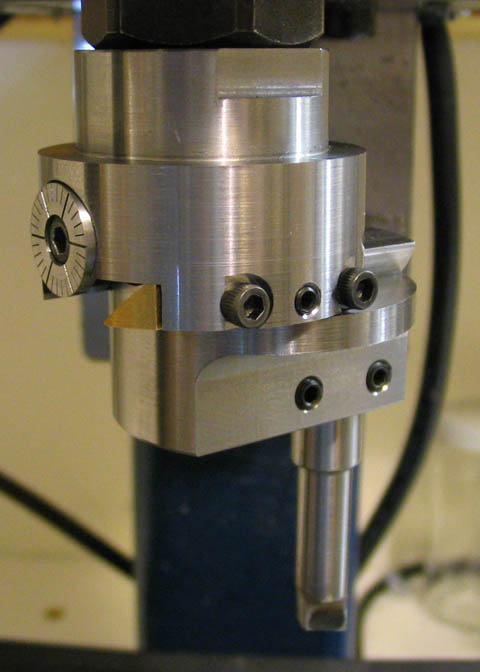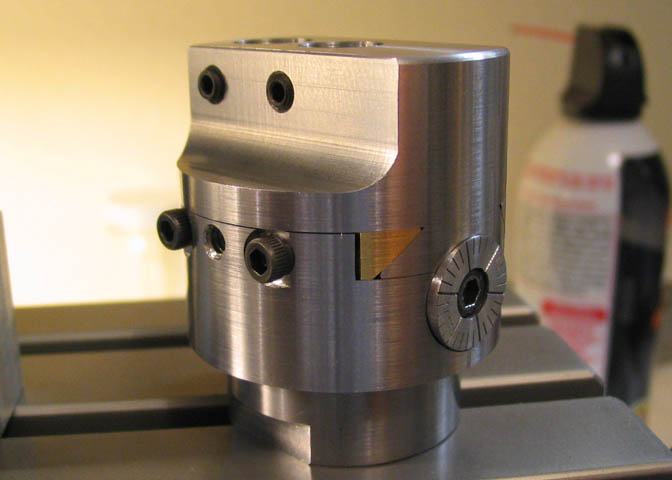Been looking at boring heads and was looking for some input from YAW as in what brand of boring head you have and if you like it or wish you had went a different route. I'm looking at an Apt, Criterion and the Flynn in a 3" flavor with a 3/4" shank soas I might use it in the mill and the lathe. All comments accepted, good, bad and even sarcastic. :big:
You are using an out of date browser. It may not display this or other websites correctly.
You should upgrade or use an alternative browser.
You should upgrade or use an alternative browser.
What type of boring head do yaw have?
- Thread starter CMS
- Start date

Help Support Home Model Engine Machinist Forum:
This site may earn a commission from merchant affiliate
links, including eBay, Amazon, and others.
hammers-n-nails
Well-Known Member
- Joined
- Mar 22, 2009
- Messages
- 206
- Reaction score
- 0
http://www.grizzly.com/products/3-Boring-Head-Set/T10168
i have one like this from grizzly, exept it looks more like the 2" model they are carrying now. the head works fine but the carbides on the boring bars that came with it are terrible. i dont know how this new line would be.
i have one like this from grizzly, exept it looks more like the 2" model they are carrying now. the head works fine but the carbides on the boring bars that came with it are terrible. i dont know how this new line would be.
The thing with boring heads is they are designed to do one job, bore accurate holes.
Having used almost all the flavours they come in, from very expensive to a home made job, they still only bore a hole. It is just that some are easier to use than others. They range from the cheapo Chinese ones, to thousand buck 'super accurate' ones, but still it boils down to making accurate holes.
It is like everything else, if used CORRECTLY, most will work superbly, even the cheapo chinese jobs, which I use, and that must now be about 15 years old and bored hundreds of really BIG holes, very accurately.
More expensive doesn't always mean better.
All you need to do is to find one that suits you in cost, looks and range. A 2" or 3" is a good size for normal boring. I would suggest one that you can change the mandrel on, as that will allow you to use it on different fitting machines, and won't become redundant as your shop grows and you get larger machinery.
People seem to think that the size of the boring head is the size of hole that it can bore, that is incorrect. If you wanted to, but I wouldn't recommend it, you could use a 2" boring head to cut a 10" diameter hole, it all depends on what sort of tool you fit into it. What the size means is the range it will work over, so if using normal sorts of boring bars, held in the normal two or three positions, a 2" one could bore from say a 1/4" to a 4" hole, depending on the cutter size, and a 3" one could manage a 6" diameter hole (just double the head size).
I'm sorry if you know all this, but for someone just coming into machining, it could be a bit of a minefield.
Blogs
Having used almost all the flavours they come in, from very expensive to a home made job, they still only bore a hole. It is just that some are easier to use than others. They range from the cheapo Chinese ones, to thousand buck 'super accurate' ones, but still it boils down to making accurate holes.
It is like everything else, if used CORRECTLY, most will work superbly, even the cheapo chinese jobs, which I use, and that must now be about 15 years old and bored hundreds of really BIG holes, very accurately.
More expensive doesn't always mean better.
All you need to do is to find one that suits you in cost, looks and range. A 2" or 3" is a good size for normal boring. I would suggest one that you can change the mandrel on, as that will allow you to use it on different fitting machines, and won't become redundant as your shop grows and you get larger machinery.
People seem to think that the size of the boring head is the size of hole that it can bore, that is incorrect. If you wanted to, but I wouldn't recommend it, you could use a 2" boring head to cut a 10" diameter hole, it all depends on what sort of tool you fit into it. What the size means is the range it will work over, so if using normal sorts of boring bars, held in the normal two or three positions, a 2" one could bore from say a 1/4" to a 4" hole, depending on the cutter size, and a 3" one could manage a 6" diameter hole (just double the head size).
I'm sorry if you know all this, but for someone just coming into machining, it could be a bit of a minefield.
Blogs
Good bit of info there, thanks. Was leaning towards the 3", not just because of the larger hole it could manage, but the 3/4" dia. boring bars it takes. I think that could be an advantage over the 1/2" bars the 2" heads use, especially in boring deep holes.
- Joined
- Jun 4, 2008
- Messages
- 3,285
- Reaction score
- 630
I have a 3" USA-made head with 3/4" straight shank and 3/4" holes. Got it with the mill. No issues to date.
I've got a 2" dia. "quality import" from Travers Tool that I got about 25 years ago. It's been fine.
In my experience, a shank to fit the milling machine taper directly, rather than a straight shank held in a collet, is much more satisfactory. A boring tool extending out of a boring head makes for a LONG lever arm, and I found that a collet just didn't make for a rigid setup.
In my experience, a shank to fit the milling machine taper directly, rather than a straight shank held in a collet, is much more satisfactory. A boring tool extending out of a boring head makes for a LONG lever arm, and I found that a collet just didn't make for a rigid setup.
I have this one. It sux. If you look at it there is no real "gib". It has to flex a rather large chunk of metal to clamp it in place after adjusting. It works but it's a pain.
http://www.grizzly.com/products/Boring-Head-Set-MT3/H5678
http://www.grizzly.com/products/Boring-Head-Set-MT3/H5678
I made one from a set of castings,
http://www.statecollegecentral.com/metallathe/MLA-7.html
It is a little big, and it is heavy, which might make it a not-so-good idea for a small mill. It does a good job for me, works very well.
Pic of mine

Here's the R-8 arbor I made for it,

To use smaller diameter tools with it, I made some bushings up, like this,

One of these days, I plan to make a smaller boring head with a little better balance.
Kevin
http://www.statecollegecentral.com/metallathe/MLA-7.html
It is a little big, and it is heavy, which might make it a not-so-good idea for a small mill. It does a good job for me, works very well.
Pic of mine

Here's the R-8 arbor I made for it,

To use smaller diameter tools with it, I made some bushings up, like this,

One of these days, I plan to make a smaller boring head with a little better balance.
Kevin
CMS,
My vote, Criterion, I own 2 of them. Check out their web site for some real good info on boring. They also sell a boreing bar that is designed to fit in the horizontal hole of a boreing head for boreing thru holes that are larger than the boreing head. Narex is another good make, I have a VHU-36 boreing and faceing head that takes bolt on shanks, This alows you to run a spindle in reverse without the shank unscrewing from the head, You can then use normal style boreing bars in the cross hole. Narex shanks are a bit pricey tho. Also for boreing bars there is no comparision between Chinese and Criterion bars, You get exactly what you pay for with this type of tooling.
Pete
My vote, Criterion, I own 2 of them. Check out their web site for some real good info on boring. They also sell a boreing bar that is designed to fit in the horizontal hole of a boreing head for boreing thru holes that are larger than the boreing head. Narex is another good make, I have a VHU-36 boreing and faceing head that takes bolt on shanks, This alows you to run a spindle in reverse without the shank unscrewing from the head, You can then use normal style boreing bars in the cross hole. Narex shanks are a bit pricey tho. Also for boreing bars there is no comparision between Chinese and Criterion bars, You get exactly what you pay for with this type of tooling.
Pete
Any of the brands you mentioned would have excellent boring heads. If buying new I'd get the Flynn or the Criterion with a slight preference to the Flynn. But the quality would be excellent either way.
I have an R8 shank Gamet Boring/Facing head rebadged by ENCO. A very capable head and the price was a steal on fleaBay. The index ring is a little on the small size if one is trying to hit tenths. My Gamet takes a 1/2" tool which does everything I need. I also have an ancient DeVlieg that takes a 3/8" shank which, in combination with it's larger index ring, edges out the Gamet when doing very small holes. The DeVlieg, however, has only a 1" adjustment range.
Make sure the head you buy reads out in diameter and that the index ring is large enough to read. I saw some head on fleaBay that took a 1/2" shank on the face but 3/4" tools out the side. this would drive me to distraction as I'd never have the cutter I wanted in the shank size the head wanted.
I have an R8 shank Gamet Boring/Facing head rebadged by ENCO. A very capable head and the price was a steal on fleaBay. The index ring is a little on the small size if one is trying to hit tenths. My Gamet takes a 1/2" tool which does everything I need. I also have an ancient DeVlieg that takes a 3/8" shank which, in combination with it's larger index ring, edges out the Gamet when doing very small holes. The DeVlieg, however, has only a 1" adjustment range.
Make sure the head you buy reads out in diameter and that the index ring is large enough to read. I saw some head on fleaBay that took a 1/2" shank on the face but 3/4" tools out the side. this would drive me to distraction as I'd never have the cutter I wanted in the shank size the head wanted.
rake60
Well-Known Member
- Joined
- Jul 8, 2007
- Messages
- 4,756
- Reaction score
- 124
Being an X2 owner, most boring heads are beyond it's capabilities.
That doesn't mean a improvised solution is impossible.
I use my home made fly cutter with an HSS tool that has been ground
for clearance. Progressive cuts are made by loosening up the screws in
the cutter and advancing the tool .010" at a time. .010" seems to work well
for a finish cut. That's an easy adjustment.

It may look a little prehistoric, but it works for me at the scale I am working on.
Rick
That doesn't mean a improvised solution is impossible.
I use my home made fly cutter with an HSS tool that has been ground
for clearance. Progressive cuts are made by loosening up the screws in
the cutter and advancing the tool .010" at a time. .010" seems to work well
for a finish cut. That's an easy adjustment.

It may look a little prehistoric, but it works for me at the scale I am working on.
Rick
L
Lew_Merrick_PE
Guest
The advantage of a larger boring head is that the dovetail supporting it is longer and stronger. The disadvantage is that it has more inertia and takes more power to spin up -- turning into the advantage that it will give you more even cutter speed in the cut.
I find that the Chinese carbide tipped boring bars are pretty uniformly junk. The cheap solution is to de-solder the tips and braze in better tips. On the other hand, it's fairly easy to make your own boring bars from S7 tool steel (my preferred solution for most of the boring I do).
I find that the Chinese carbide tipped boring bars are pretty uniformly junk. The cheap solution is to de-solder the tips and braze in better tips. On the other hand, it's fairly easy to make your own boring bars from S7 tool steel (my preferred solution for most of the boring I do).
Like Kevin, (Joeby) I made my own. It may not be what you want to spend your time on, but if you make your own, you can have exactly what you want.
This one is small, as I made it for a Taig mill, but you could scale it to fit your needs. It mounts directly to the spindle nose on my mill. Could be made with a shank for R8, too. Prints are by Stephen Campbell, who is a member here (walnotr). You can find the prints on my web page, if you would like to see them.
Dean


This one is small, as I made it for a Taig mill, but you could scale it to fit your needs. It mounts directly to the spindle nose on my mill. Could be made with a shank for R8, too. Prints are by Stephen Campbell, who is a member here (walnotr). You can find the prints on my web page, if you would like to see them.
Dean


Rake60, I to have thought about an extra long homebrew flycutter and using an indicator to adjust.
Starbolin, yes the ones that adjust .100" per turn will be tough to read compared to the ones that are .050" per turn.
Deanofid, man that's a nice piece of work there, got my vote for the next engine of the month. Think I'll cruse on over to your page and see what ya got.
Starbolin, yes the ones that adjust .100" per turn will be tough to read compared to the ones that are .050" per turn.
Deanofid, man that's a nice piece of work there, got my vote for the next engine of the month. Think I'll cruse on over to your page and see what ya got.
Similar threads
- Replies
- 10
- Views
- 4K




